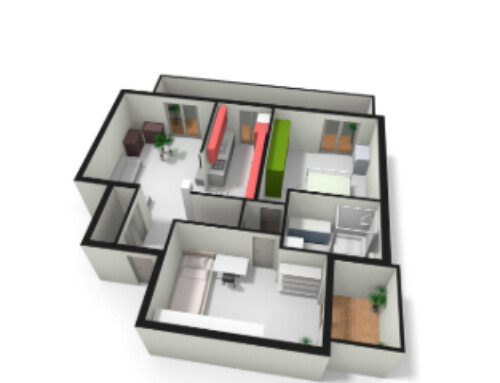 I love mobile technology and I have really been enjoying watching the advent of some very cool products finally become real in our industry. We have been talking about it for years and today, finally, there are some excellent mobile tools on the market. Make no mistake, though, mobile is still in the baby step phase in my opinion and we are going to see some big advances in the coming years. Mobile, after all, is destined to become the norm rather than the add on, so rather than just catching up to our MLS desktop tools it will pass them eventually. What is that going to look like?
I love mobile technology and I have really been enjoying watching the advent of some very cool products finally become real in our industry. We have been talking about it for years and today, finally, there are some excellent mobile tools on the market. Make no mistake, though, mobile is still in the baby step phase in my opinion and we are going to see some big advances in the coming years. Mobile, after all, is destined to become the norm rather than the add on, so rather than just catching up to our MLS desktop tools it will pass them eventually. What is that going to look like?
GPS and Mapping
I think the key in thinking about mobile and what it can really become for our industry is to think back to what mobile devices bring with them before we even access the MLS information. Mobile devices, for example, have GPS and mapping capabilities. Of course we all think about searching for properties on maps, driving directions and so on, but GPS and mapping have many more uses that have yet to be built into our mobile tools in any serious way. Retailers for one are hugely interested in tapping into location-based ads to both our real estate professionals and their clients. Mapping also take analytics to another level yet we really haven’t seen any serious mobile analytic tools yet on our MLS products, but we will. Every time we move with a smart mobile device we are creating a trail that can be saved and analyzed and that data is very important to understand our patterns and behavior. Huge money is and will be spent to tap into that data.
Visualizing Statistics and Trends
Being able to represent statistics and trends for customers on mobile devices should be a natural part of telling the real estate story as well. Right now we can search for homes and display homes but we haven’t really seen mobile go to that next level. I am confident we will see layers and layers of strong analytical data get added to these tools as they mature.
CRM Tools
Our devices also allow for easy integration with contacts, but this has not really been developed yet. True CRM (Customer Relationship Management) is an area that has huge potential but has not been addressed well even in the PC or Mac desktop world for the average user let alone on mobile. We have Outlook and Mac contacts and that is what the majority of people use but imagine the possibilities of having a truly powerful CRM tool that is also mobile. Every smart mobile device has a contact manager but all they are really are glorified address books. Good CRM software tracks history and allows you to manage ongoing contacts with more elegance than a simple contact manager. Schedules, calendars, contacts are integrated in ways that allow users to manage projects, project business, automate communications and maintain a clear view of your overall business operations. When that is also mobile you are in control anywhere you choose to work. In real estate that might allow you to set up and launch an automated email campaign to announce a new sale, while you are sitting at your favorite coffee shop or to send off a seasonal mailing to everyone you have done business with. Better yet, when you get that call from someone you worked with two years ago you have all of their historic information right on your phone to jog your memory.
Transaction and Document Management
How about transaction and document management? This is a natural for our mobile devices where all the parties of a transaction can review and sign documents, see updates, etc., and it may be the spark that really makes transaction management a reality. It’s beginning and we are seeing tools that allow remote document viewing and signing. Not many people are using these tools yet but they will in the not too distant future.
Photo and Video Tools
True photo and video integration is a natural for real estate that still has a long way to go. We see great examples of how mobile photos and videos can be used on sites like Facebook and YouTube but imagine if mobile templates allowed you to take advantage of your smart phone or tablet’s camera and video features to communicate visually with your clients in real estate. Sure, it can be done today with a little creativity but for the mainstream to use it, it needs to be simple. Also, these tools should all be integrated as part of a mobile suite of products. In real estate, these products naturally have to be integrated into the MLS system.
We Need More Than RETS Integration
Integration with MLSs will be increasing quickly as well, due to a strong field of mobile competitors. The first stages of integration are things that can easily be accessed via the RETS standard but agents are demanding much more. Agents want to see their “My Favorite” list from the MLS systems and when they enter a search and save it on a mobile device they want that search to show up in the MLS system. They want the ability to not only edit listings from the field but to add and edit contacts and photos and have all of these edits sync with the MLS system. Likewise, when they create a new map search with a custom polygon on the MLS map search wouldn’t it make sense to be able to use that same area search on a mobile device? You can’t do all of these things today but you will be able to in the not too distant future. Some vendors are creating open APIs to make this happen and it will be really fun to see just how far this integration goes and the level of two-way integration that results.
The New MLS Mobile Paradigm
We all talk about how mobile will be the real estate platform in the not too distant future. I think the future has arrived. I’m keeping a watch for the mobile solutions that do more than just give us access to the MLS data. I’m looking for mobile tools that change the paradigm and take real estate to another level where we really use the tools available on our high-powered mobile devices in ways that couldn’t happen when we were anchored to a desktop. I want to see MLS, with CRM and incredible GPS tools that take advantage of video and the high-resolution photos we have available through devices today. I want to easily review and sign contracts from the same device using the same software and I want my documents to be archived and accessible through my CRM system. I want everything I do to be tracked and stored so I can access it and mine it for future campaigns. I want my MLS data available on every module where it makes sense and I want it all working under a simple, common interface. I want data to really flow automatically throughout the modules I work with. I want to put data in once and only once and have it available anywhere I need it and I want the ability to share that data effortlessly with outside technology tools if needed. Is that too much to ask?
I think it’s time to expand our thinking of what MLS can and should be beyond what we could do when we were bound to our desks. Let’s see who shares that vision to become the next big game changer in the MLS industry.





I could not agree more!! The million dollar question is who has the solution to merge all of these together? I am reading your latest “technology update” but find the lack of one company providing the services you describe in your article. Thanks for all the greta info!
Great piece Mike.
I’m looking forward to discovering whether the MLSs really have the wherewithal to put the right pieces together. If we don’t Google (or someone else) will. I wonder if we have the know-how, we certainly don’t have the technological skills to make it happen in a highly functional way. Why is collaboration such a dirty word? Are egos getting in the way?
Thanks George. I think there are vendors in our MLS world that could put the pieces together. The problem, as I see it, is MLSs are not willing to pay them to do it. We have compressed fees for MLS systems so low per member there isn’t a lot of fat anymore for our vendors to develop really cool new products. What this creates then is a an outstanding opportunity for 3rd party technology companies, outside of our core space, with big bankrolls and vision, to fill the vacuum that exists. I would love to see our MLSs realize that we either have to invest more in our core technology vendors or accept that in the near future we will be giving up control of that core technology to 3rd party opportunists that will.